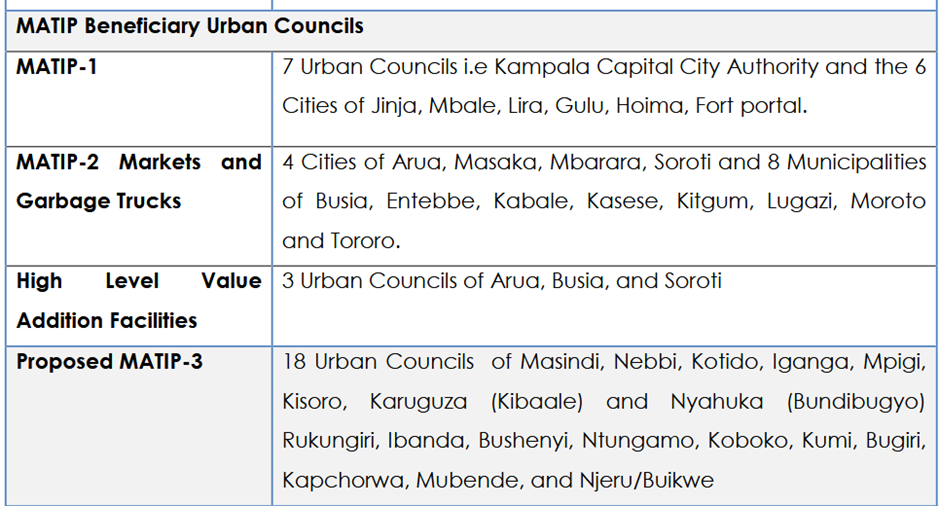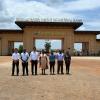Government of Uganda in partnership with African Development Bank (ADB) develops districts markets through the Markets and Agricultural Trade Improvement Programme (MATIP).
The program focuses on upgrading markets and enhancing agricultural trade with the aim of improving market infrastructure, promoting better working conditions for vendors, and ultimately contributing to boosting agricultural trade, poverty reduction and economic growth.
Introduction
The Markets and Agricultural Trade Improvement Programme, Project-1&2 (MATIP-1&2) is one of the government’s strategic investments aimed at improving marketplace economic and social infrastructure to provide opportunities for production and marketing of agricultural commodities, to enhance incomes of vendors, create employment opportunities, as well as increasing revenue generation by Local Governments.
So far 19 Markets have been constructed under MATIP Programme. These Markets were built in Phases where Phase 1 (MATIP-1) covered 7 markets of Jinja, Mbale, Lira, Gulu, Hoima, Mpanga in Fortportal and Wandegeya in Kampala Capital City Authority While Phase -2 (MATIP-2) covered 12 Markets of Arua, Busia, Kitooro in Entebbe, Kabale, Kasese, Kitgum, Lugazi, Masaka, Mbarara, Lopeduru in Moroto, Soroti, Tororo Plus 3 High-Level Value Addition Facilities in Arua City, Soroti City and Busia Municipality.
MATIP-3 is a continuation of this MATIP Programme targeting the re-development of additional 18 dilapidated Main Markets in Urban Councils of Masindi, Nebbi, Kotido, Iganga, Mpigi, Kisoro, Karuguza (Kibaale) and Nyahuka (Bundibugyo) Rukungiri, Ibanda, Bushenyi, Ntungamo, Koboko, Kumi, Bugiri, Kapchorwa, Mubende, and Njeru/Buikwe.
Summary of the MATIP Project phases and beneficiary urban centres

Goal of MATIP:
The overall Goal of MATIP, is to contribute to poverty reduction and economic growth in Uganda through enhanced commercialization of agricultural produce and other merchandise.
Specific Objectives include;
To improve marketplace economic and social infrastructure thus inducing incremental production and marketing of agricultural commodities.
- Enhancing the incomes of Vendors
- Reducing post-harvest losses
- Increasing employment and customer satisfaction.
- Trade facilitation and enhancement through Value Addition.
Key impact areas for this intervention
- Impact on vendor incomes Increased Annual incomes of the Agricultural Market Vendors by 52% from UGX 231 billion in 2016 to UGX 351 billion in 2023 with the best performing Markets being Gulu, Jinja, Lira, Mbale, Mpanga, Lopeduru in Moroto, Kitooro in Entebbe Soroti, Tororo, Mbarara, and Arua. The average farmer incomes have increased from UGX 1.5 million before Markets construction to UGX 4.2 million.
- Impact on local revenue collections; The Markets have enhanced revenue collections ranging from UGX 60million to 900million giving a cumulative revenue of UGX 4,481,337,773 annually at 70% occupancy. If all Vendors pay rental fees there is a potential of contributing about UGX 10 billion annually and UGX 17 billion at full capacity.
- Market Infrastructure modernization through rebuilding and modernizing existing markets, addressing issues including poor management, disrepair, and overcrowding.
- Improvement of Working Conditions through providing better facilities, to create a more conducive environment for vendors (especially youth and women), mainly dealing in agricultural produce.
- Boosting Agricultural Trade through facilitating marketing of agricultural produce, enhancing incomes for vendors ( especially women and youth) and creating employment opportunities.
Opportunities for private sector
- Employment as vendors; The Markets employ between 70,000 – 90,000 people directly and indirectly out of which 31,000 are vendors, their assistants, service providers. Vendor resettlement is a continuous process since the Markets are Projected to gain full occupancy in 15 years from the date entry.
- Investment opportunities; About 28,000 New Businesses have been created including retail shops, restaurants, Mobile Money, Agent banking, Clinics/Drug shops, saloons etc.
- Opportunities for value addition; the project provides three high level value addition facilities in Arua, Busia and Soroti Markets. Products such as Maize Flour, Cassava flour, groundnut paste, fish, beef, are all graded and standardised. This has enhanced value addition and attracted high prices for the vendors.
- Cross boarder trading opportunities; these facilities have boosted Cross Border Trade opportunities for markets near border posts like Busia, Kabale, Masaka, Kasese, Arua among others. These have enabled the mobilization of Commercial Farmers to supply these complexes, provided quality, tested, and certified products for both internal and external Markets.
- Supportive Business Development services; these facilities have attracted BDS from municipal councils inform of trade facilitation, capacity building to reduce post-harvest handling loses, as well as supporting marketing of agricultural commodities.
- Security of businesses; the facilities provide CCTV cameras to enhance security for vendors and their merchandise, and have regular announcements on public address system for effective communication within the market premises.



